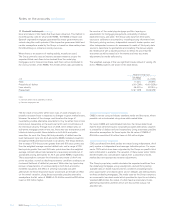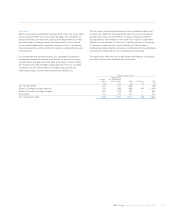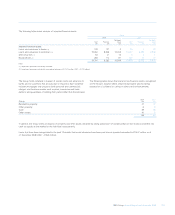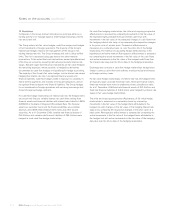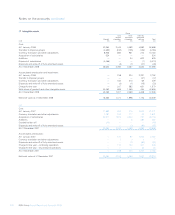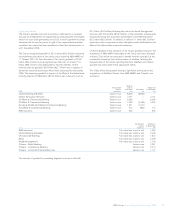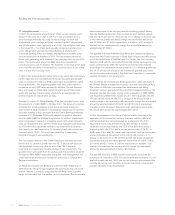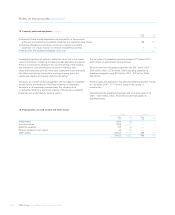RBS 2008 Annual Report Download - page 215
Download and view the complete annual report
Please find page 215 of the 2008 RBS annual report below. You can navigate through the pages in the report by either clicking on the pages listed below, or by using the keyword search tool below to find specific information within the annual report.
RBS Group Annual Report and Accounts 2008214
Notes on the accounts continued
13 Derivatives
Companies in the Group transact derivatives as principal either as a
trading activity or to manage balance sheet foreign exchange, interest
rate and credit risk.
The Group enters into fair value hedges, cash flow hedges and hedges
of net investments in foreign operations. The majority of the Group’s
interest rate hedges relate to the management of the Group’s non-
trading interest rate risk. The Group manages this risk to Value-at-Risk
limits. The risk is assessed using gap reports that show maturity
mismatches. To the extent that such mismatches exceed predetermined
limits they are closed by executing derivatives principally interest rate
swaps. Suitable larger ticket financial instruments are fair value hedged;
the remaining exposure, where possible, is hedged by derivatives
documented as cash flow hedges and qualifying for hedge accounting.
The majority of the Group’s fair value hedges involve interest rate swaps
hedging the interest rate risk in recognised financial assets and
financial liabilities. Cash flow hedges relate to exposure to variability in
future interest payments and receipts on forecast transactions and on
recognised financial assets and financial liabilities. The Group hedges
its net investments in foreign operations with currency borrowings and
forward foreign exchange contracts.
For cash flow hedge relationships of interest rate risk, the hedged items
are actual and forecast variable interest rate cash flows arising from
financial assets and financial liabilities with interest rates linked to LIBOR,
EURIBOR or the Bank of England Official Bank Rate. The financial
assets are customer loans and the financial liabilities are customer
deposits and LIBOR linked medium-term notes and other issued
securities. As at 31 December 2008, variable rate financial assets of
£34.6 billion and variable rate financial liabilities of £56.4 billion were
hedged in such cash flow hedge relationships.
For cash flow hedging relationships, the initial and ongoing prospective
effectiveness is assessed by comparing movements in the fair value of
the expected highly probable forecast interest cash flows with
movements in the fair value of the expected changes in cash flows from
the hedging interest rate swap or by comparing the respective changes
in the price value of a basis point. Prospective effectiveness is
measured on a cumulative basis i.e. over the entire life of the hedge
relationship. The method of calculating hedge ineffectiveness is the
hypothetical derivative method. Retrospective effectiveness is assessed
by comparing the actual movements in the fair value of the cash flows
and actual movements in the fair value of the hedged cash flows from
the interest rate swap over the life to date of the hedging relationship.
Exchange rate contracts in cash flow hedge relationships hedge future
foreign currency cash inflow and outflows; mainly principal and interest
on foreign currency loans.
For fair value hedge relationships of interest rate risk, the hedged items
are typically large corporate fixed-rate loans, fixed-rate finance leases,
fixed-rate medium-term notes or preference shares classified as debt.
As at 31 December 2008 fixed rate financial assets of £42.5 billion and
fixed rate financial liabilities of £46.4 billion were hedged by interest rate
swaps in fair value hedge relationships.
The initial and ongoing prospective effectiveness of fair value hedge
relationships is assessed on a cumulative basis by comparing
movements in the fair value of the hedged item attributable to the
hedged risk with changes in the fair value of the hedging interest rate
swap or by comparing the respective changes in the price value of a
basis point. Retrospective effectiveness is assessed by comparing the
actual movements in the fair value of the hedged items attributable to
the hedged risk with actual movements in the fair value of the hedging
derivative over the life to date of the hedging relationship.


